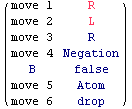Propositional logic.
((A∧B)∨((A∧¬B)∨(¬A∧B))).
Our first example is the propositional formula ((A∧B)∨((A∧¬B)∨(¬A∧B))), with A, B atomic, A true and B false.
In[357]:=
![]()
In[358]:=
![]()
Out[358]=
![]()
The formula is true, because A∧¬B is true (A is assumed true, and B is assumed false). The only winning strategy for Eloise is to defend first t.(A∧¬B)∨(¬A∧B)), then t.A∧¬B, because both judgements are true. Eventually, Abelard can choose either to play from t.A, or from t.¬B. In the first case Abelard says that A is false, that is, he attacks A. In the second one, Abelard eventually plays from f.B: his thesis is that B is true, that is, he defends B. In both cases, the truth value of A, B is the opposite of what Abelard says. If Abelard attacks A, eventually Abelard plays from t.T, because t.T is a subjudgement of t.A belonging to Abelard. If Abelard defends B, eventually he plays from f.F, because f.F is a subjudgement of f.B belonging to Abelard. In the first case, Abelard is attacking the truth, in the second one he is defending the falsity. In both cases Abelard has no moves available: t.T, f.F have no subjudgements. Abelard gives up and loses.
We play a saved play as example.
In[359]:=
![savedplay = ( "move 1" "R" ) ; ... " Tarski[F20, "FontSize = 18, TreeWidth=500, LevelHeight=70", savedplay] ;](../HTMLFiles/index_10.gif)
![[Graphics:../HTMLFiles/index_11.gif]](../HTMLFiles/index_11.gif)
![]()
![[Graphics:../HTMLFiles/index_13.gif]](../HTMLFiles/index_13.gif)
![]()
![[Graphics:../HTMLFiles/index_15.gif]](../HTMLFiles/index_15.gif)
![[Graphics:../HTMLFiles/index_16.gif]](../HTMLFiles/index_16.gif)
![]()
![]()
![]()
![[Graphics:../HTMLFiles/index_20.gif]](../HTMLFiles/index_20.gif)
![[Graphics:../HTMLFiles/index_21.gif]](../HTMLFiles/index_21.gif)
![]()
![]()
![]()
![[Graphics:../HTMLFiles/index_25.gif]](../HTMLFiles/index_25.gif)
![[Graphics:../HTMLFiles/index_26.gif]](../HTMLFiles/index_26.gif)
![]()
![]()
![]()
![[Graphics:../HTMLFiles/index_30.gif]](../HTMLFiles/index_30.gif)
![[Graphics:../HTMLFiles/index_31.gif]](../HTMLFiles/index_31.gif)
![]()
![]()
![]()
![[Graphics:../HTMLFiles/index_35.gif]](../HTMLFiles/index_35.gif)
![[Graphics:../HTMLFiles/index_36.gif]](../HTMLFiles/index_36.gif)
![]()
![]()
![]()
![[Graphics:../HTMLFiles/index_40.gif]](../HTMLFiles/index_40.gif)
![[Graphics:../HTMLFiles/index_41.gif]](../HTMLFiles/index_41.gif)
![]()
![]()
![[Graphics:../HTMLFiles/index_44.gif]](../HTMLFiles/index_44.gif)
![]()

Created by Mathematica (October 17, 2006)